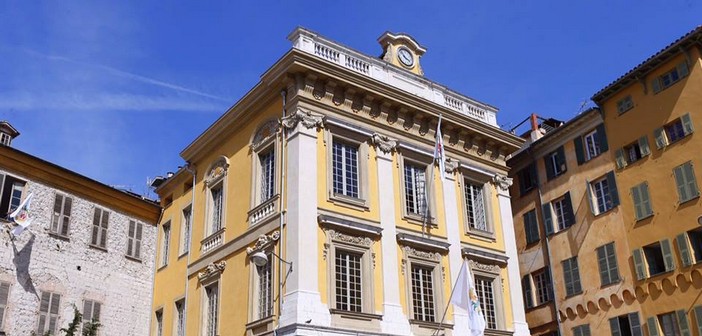Nice is in a way a privileged city. In 1144, the people of Nice obtained communal freedoms. They enacted their own rules and elected their representatives, who would administer the city.
This privilege was never interrupted, and whether under the sovereignty of the County of Provence, under the House of Savoy after 1388, or after 1860 under the sovereignty of France, it was the people of Nice who appointed the men called to represent them.
The first communal palace was located on the Castle Hill where the vital and spiritual centers of the city were. The urban development of the lower city and the fortifications of the 16th century led to the transfer of administrative and spiritual powers to the lower city.
Thus, between 1574 and 1581, the communal palace was built on Saint Francis square where the church and the Franciscan convent were located. We will revisit this. In 1584, the municipal administration moved into this building. It remained in this edifice until 1868, with an interruption during the revolutionary and French occupation period from 1792 to 1814.
The communal palace became the labor exchange in 1893 and, after liberation in 1945, the union headquarters of the CGT. A first renovation took place in 1978. In 2009, it was decided to rehabilitate this 17th-century Baroque palace, to restore its splendor and gilding. The municipality’s projects continue the policy of renovating Nice’s cultural heritage.
Thus, the restoration of Saint Francis square has already been planned. Every day, the people of Nice see this Saint Francis tower give the time, and where, according to the whims of the wind, the white flag with the eagle flies, the symbol of the Red Count, hence its color.
This is also a renovation project, returning the buildings currently used for garbage collection to their original purpose. We will leap back in time, going back six centuries to the 13th century. Saint Francis square was the site of a church and a Franciscan convent. This building, dating from 1240, or the 13th century, is the oldest in Nice.
Indeed, it was transformed after the revolution. The various parts of the church, the cloister, and its ambulatory had become public buildings, a cinema, and even garbage storage. The rehabilitation project will restore this church to its intended use. During the visit on April 16, 2016, the mayor acted as a historical architect, showing the walls, the vaults, and the nave of this ancient building.
The Franciscan church had a single nave, oriented north-south, with the choir located where the screen and stage of this cabaret cinema, The Capitol, were.
Then we return to this Baroque-style communal palace, which will certainly be the most beautiful of our city after its restoration.
The communal organization included the grand council of 40 members, who appointed the small council of eight members sitting a floor below, and the four consuls of Nice were appointed by this restricted council. A door protected access to the grand council against possible demonstrations by the population.
In this communal palace, there are plans to restore the mural frescoes and Baroque ceilings. At the beginning of the 20th century, a regrettable trend was to cover the decorations and mural frescoes under lime plasters. It is a laborious task to find them and restore them.
This is another challenge that the municipality of Nice, proud and protective of its heritage, is ready to take on. We look forward to rediscovering these treasures of our heritage, including this 13th-century church whose foundations are miraculously intact.
We can now admire the façade of the former communal palace and appreciate the work done to restore this building to its splendor and beauty.
Thierry Jan


